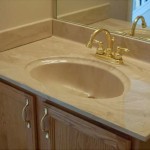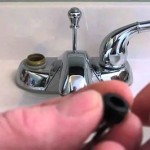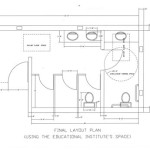How To Replace The Drain In Bathroom Sink
Replacing a bathroom sink drain is a common plumbing task that homeowners can often accomplish themselves, saving on professional plumbing service fees. While it may seem daunting at first, the process is essentially straightforward with the right tools, materials, and a clear understanding of each step. This article provides a comprehensive guide on how to replace a bathroom sink drain, covering everything from preparation and disassembly to installation and leak testing.
Before beginning any plumbing project, safety is paramount. Always wear appropriate safety glasses to protect the eyes from debris. Additionally, it is advisable to wear gloves to maintain hygiene and provide a better grip on tools. Finally, ensure that the water supply to the sink is completely shut off. This prevents unexpected water flow during disassembly, which can lead to water damage and unnecessary complications. Locate the shut-off valves, typically found under the sink, and turn them clockwise until they are fully closed. After closing the valves, turn on the faucet briefly to relieve any remaining pressure in the pipes.
Gathering The Necessary Tools and Materials
Having the right tools and materials readily available will streamline the drain replacement process and minimize potential delays. The following is a list of essential items:
- New Sink Drain Assembly: Ensure that the new drain assembly is compatible with the sink. Check the size and type (e.g., pop-up, grid strainer, basket strainer) to make an informed purchase.
- Basin Wrench (Sink Wrench): This specialized wrench is designed to reach and loosen the nuts that secure the drain assembly to the sink from underneath.
- Channel-Lock Pliers: These pliers provide a secure grip for loosening or tightening nuts and fittings.
- Adjustable Wrench: Another versatile wrench for various plumbing tasks, including tightening connections.
- Putty Knife or Scraper: Used to remove old plumber's putty or sealant.
- Plumber's Putty or Silicone Sealant: Used to create a watertight seal between the drain flange and the sink.
- Towel or Bucket: To catch any residual water or debris during disassembly.
- Safety Glasses and Gloves: For eye and hand protection.
- Penetrating Oil (Optional): For loosening stubborn nuts or fittings.
Acquiring these tools and materials beforehand will ensure a smooth and efficient drain replacement process.
Removing The Old Drain Assembly
The removal of the old drain assembly requires a systematic approach to avoid damaging the sink or plumbing fixtures. Start by disconnecting the P-trap, which is the curved pipe located beneath the sink. Place a bucket underneath the P-trap to catch any remaining water. Loosen the slip nuts that connect the P-trap to the drain tailpiece and the drainpipe in the wall. Once the slip nuts are loosened, carefully remove the P-trap.
Next, disconnect the drain stopper linkage. This typically involves loosening a screw or clip that connects the horizontal pivot rod to the vertical lift rod. Once disconnected, remove the lift rod from the top of the sink and the pivot rod from the drain tailpiece.
With the P-trap and drain stopper linkage removed, the next step is to loosen the large nut that secures the drain body to the sink. This nut is usually located directly underneath the sink, between the sink and the drain tailpiece. Use a basin wrench to loosen this nut. Due to corrosion or mineral buildup, this nut can be extremely difficult to loosen. Applying penetrating oil and allowing it to soak for a few minutes can help. If the nut is severely corroded, it may be necessary to carefully cut it with a small hacksaw or rotary tool, being extremely cautious not to damage the sink or drain tailpiece.
Once the nut is loosened, carefully push the drain body up through the sink. On the top side of the sink, there will be a drain flange sealed to the sink surface with plumber's putty or silicone. Use a putty knife or scraper to carefully break the seal between the flange and the sink. Once the seal is broken, the old drain assembly can be completely removed.
Before proceeding, thoroughly clean the sink surface around the drain opening. Remove any remaining plumber's putty, silicone, or other debris. A clean surface is essential for creating a proper seal with the new drain assembly.
Installing The New Drain Assembly
Installing the new drain assembly requires careful attention to ensure a watertight seal. Start by applying a generous amount of plumber's putty to the underside of the new drain flange. Roll the putty into a rope and press it firmly against the flange. The putty should completely fill the gap between the flange and the sink surface.
Insert the new drain flange into the drain opening from the top of the sink. From underneath the sink, slide the rubber or fiber washer onto the drain tailpiece, followed by the cardboard or metal friction ring. This washer and ring provide additional support and help to create a tight seal. Then, screw the mounting nut onto the drain tailpiece, tightening it by hand until it is snug.
Using a basin wrench, tighten the mounting nut further until the drain flange is firmly seated against the sink. Avoid overtightening, as this could crack the sink or damage the drain assembly. The goal is to achieve a tight, watertight seal without excessive force. Remove any excess plumber's putty that squeezes out from under the flange.
Next, install the drain stopper linkage. This typically involves inserting the pivot rod into the drain tailpiece and securing it with a nut. Connect the lift rod to the pivot rod using the appropriate clip or screw. Adjust the linkage to ensure that the drain stopper opens and closes properly.
Reattach the P-trap to the drain tailpiece and the drainpipe in the wall. Tighten the slip nuts securely, but avoid overtightening. Ensure that the P-trap is properly aligned to allow for smooth water flow.
Testing For Leaks
After installing the new drain assembly, it is crucial to test for leaks. First, ensure that the drain stopper is closed. Then, slowly turn on the water supply to the sink. Fill the sink with water and observe the drain assembly for any signs of leakage. Check the connection between the drain flange and the sink, the mounting nut underneath the sink, the drain stopper linkage, and the P-trap connections.
If any leaks are detected, immediately turn off the water supply. Identify the source of the leak and tighten the appropriate connections. If the leak persists, disassemble the connection, inspect the components for damage, and reassemble with fresh plumber's putty or sealant. It may be necessary to replace a damaged washer or fitting to eliminate the leak.
Once all leaks have been addressed, repeat the leak testing process to ensure that the drain assembly is completely watertight. Allow the water to sit in the sink for an extended period to detect any slow leaks that may not be immediately apparent.
Following these steps carefully will result in a successful drain replacement, ensuring a functional and leak-free bathroom sink. If any part of the process feels too complicated or outside of skillset, contacting a professional plumber is always a viable option and should be considered.

How To Replace A Drain In The Bathroom Sink Right Way

Sink Drain Replacement Bathroom
How To Install Bathroom Sink Drain Queen Bee Of Honey Dos

How To Replace A Bathroom Sink Drain
How To Install Bathroom Sink Drain Queen Bee Of Honey Dos

How To Replace Bathroom Sink Stopper Avg Cost 25 65 1 2hrs

Bianchina Swapping Out A Bathroom Sink Drain And Pop Up

How To Replace A Sink Stopper Quick And Simple Home Repair

How Replace A Bathroom Sink Drain
How To Install Bathroom Sink Drain Queen Bee Of Honey Dos
Related Posts







